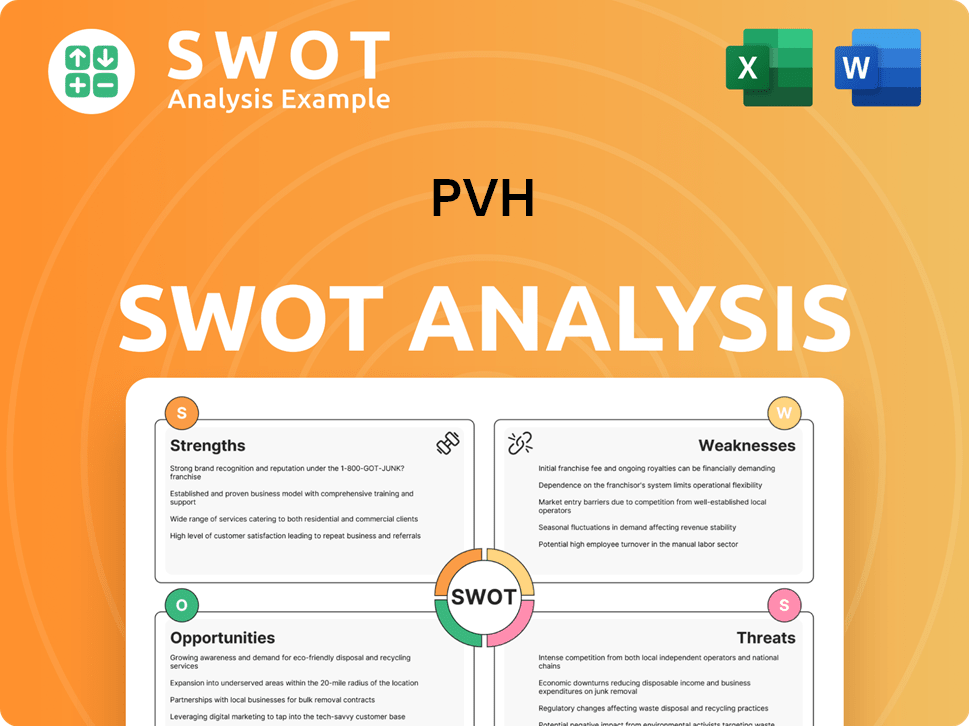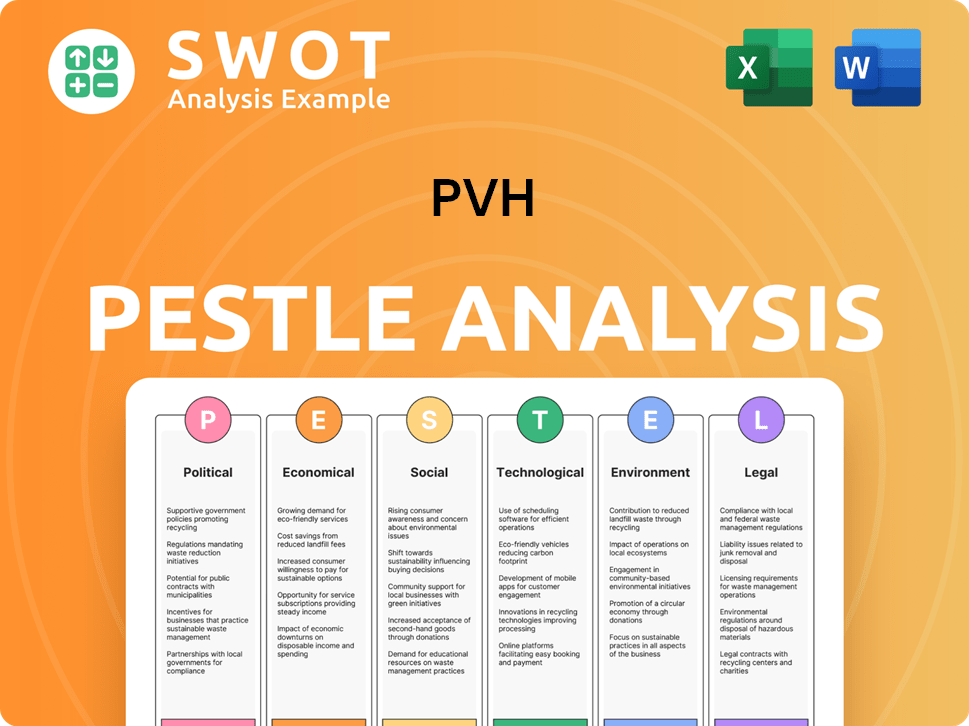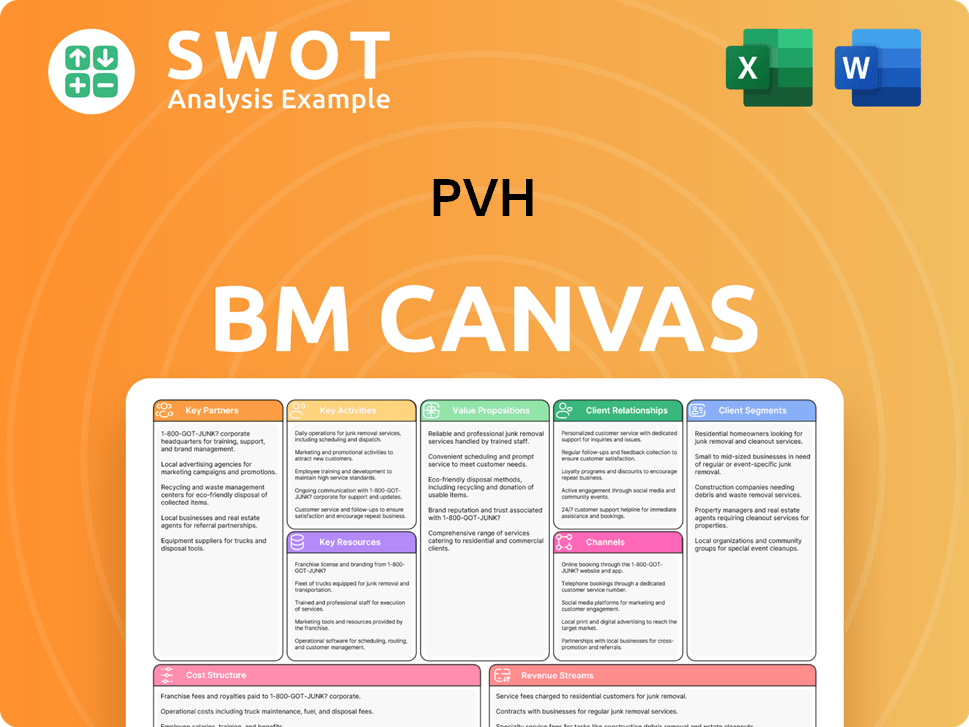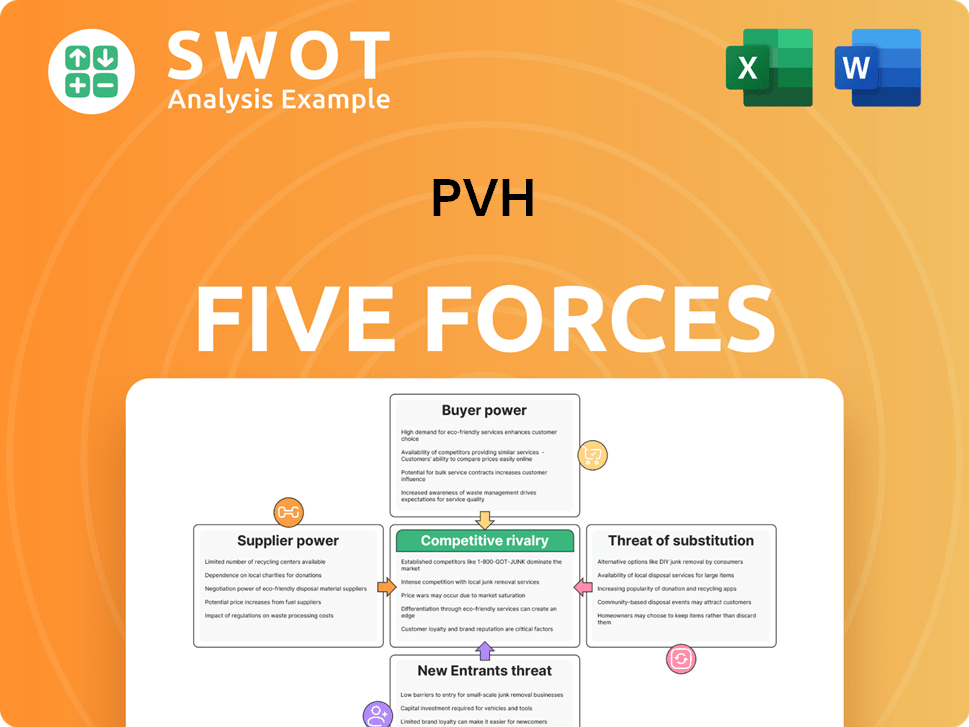PVH Bundle
Can PVH Corp. Conquer the Ever-Changing Apparel Arena?
In the ever-evolving fashion industry, understanding the PVH SWOT Analysis is crucial. PVH Corp., home to iconic brands like Calvin Klein and Tommy Hilfiger, navigates a complex PVH competitive landscape shaped by consumer trends and digital advancements. This analysis delves into the company's strategic positioning and its battle against fierce PVH competitors.

This deep dive into PVH Corp market analysis will explore its global market presence and PVH Corp's market share analysis 2024, assessing Tommy Hilfiger competitors and the competitive landscape. We'll uncover PVH Corp's competitive advantages and dissect the strategies of PVH Corp competitors to understand its position in the fashion industry competition. Ultimately, we aim to equip you with actionable insights into PVH Corp's financial performance compared to rivals and its future growth prospects.
Where Does PVH’ Stand in the Current Market?
PVH Corp. operates within the global apparel industry, focusing on branded lifestyle apparel. The company's core operations revolve around designing, marketing, and selling a diverse range of products, including men's and women's sportswear, jeanswear, intimate apparel, and accessories. Its value proposition centers on offering recognizable brands with a global presence, catering to a wide consumer base through multiple distribution channels.
The company's primary brands, Calvin Klein and Tommy Hilfiger, drive its market position. These brands have significant brand recognition and global reach, contributing substantially to PVH Corp.'s revenue. The company's financial performance, including its revenue of $9.218 billion in fiscal year 2023, reflects its substantial scale within the industry.
PVH Corp. strategically emphasizes strengthening its direct-to-consumer (DTC) capabilities and digital transformation initiatives. This shift aims to enhance customer engagement, optimize inventory management, and improve profitability. The company's focus on improving its gross margin, which stood at 58.7% for the fourth quarter of 2023, underscores its commitment to financial health and operational efficiency.
PVH Corp. consistently ranks among the top apparel companies globally based on revenue. The company's revenue for fiscal year 2023 was $9.218 billion, demonstrating its significant market presence. This performance places it favorably compared to many industry averages.
PVH Corp. has a strong presence in North America, Europe, and Asia. It operates through wholesale, retail (company-owned stores), and licensing channels. The company continues to explore growth opportunities in emerging markets, expanding its global footprint.
PVH Corp. is actively strengthening its direct-to-consumer (DTC) capabilities and digital transformation initiatives. This strategic pivot aims to enhance customer engagement and improve profitability. The DTC channel is a key area of focus for future growth.
The company's fiscal 2023 results highlighted a focus on improving its gross margin, which stood at 58.7% for the fourth quarter of 2023. This demonstrates the company's commitment to financial health and operational efficiency, which is crucial for navigating the PVH competitive landscape.
PVH Corp. faces intense competition from both established players and emerging brands within the fashion industry. The apparel market share is highly contested, with numerous companies vying for consumer attention and market dominance. Understanding the strategies of PVH Corp's competitors is crucial.
- Key competitors include other major apparel brands with global reach and strong brand recognition.
- Competition also comes from fast-fashion retailers and online platforms that offer similar products at different price points.
- Economic fluctuations and shifts in consumer spending significantly impact the apparel market.
- PVH Corp's ability to innovate and adapt is essential for maintaining its market position.
PVH SWOT Analysis
- Complete SWOT Breakdown
- Fully Customizable
- Editable in Excel & Word
- Professional Formatting
- Investor-Ready Format

Who Are the Main Competitors Challenging PVH?
The PVH competitive landscape is shaped by a dynamic global apparel market. The company faces competition from a wide array of players. Understanding the competitive environment is crucial for assessing PVH Corp market analysis and its strategic positioning.
PVH competitors include both direct rivals with similar brand portfolios and distribution networks, and indirect competitors, such as fast fashion retailers and sportswear giants. The competitive dynamics are influenced by factors like price, innovation, branding, distribution, and technology. The apparel industry is constantly evolving, requiring companies to adapt to changing consumer preferences and market trends.
To learn more about the financial aspects and business model, explore Revenue Streams & Business Model of PVH.
Direct competitors are companies that offer similar products and target the same customer segments as PVH. These companies often have strong brand portfolios and global distribution networks. Key players include The TJX Companies, VF Corporation, and Levi Strauss & Co.
Indirect competitors include brands that compete for consumer spending, even if they don't offer identical products. These can include premium and luxury brands like Ralph Lauren and Capri Holdings, fast fashion retailers such as Inditex (Zara) and H&M Group, and sportswear companies like Nike and Adidas.
Competition in the apparel market is multifaceted, involving price, innovation, branding, distribution, and technology. Fast fashion retailers challenge traditional models with quick-to-market strategies. Digital-native brands utilize e-commerce and social media to reach consumers directly.
The industry sees constant shifts due to mergers, acquisitions, and emerging players. Tapestry Inc.'s acquisition of Capri Holdings reshapes the landscape, creating larger conglomerates. Sustainable fashion and niche markets are also growing, pushing established companies to adapt.
Intense competition occurs in specific segments like denim and sportswear. Brands constantly compete for consumer attention through celebrity endorsements and strategic collaborations. This impacts market share and brand perception.
Economic trends significantly influence the apparel market. Consumer spending habits, inflation, and global economic conditions affect demand and competition. Companies must adapt to these changes to maintain profitability and market share.
Analyzing PVH Corp's competitive advantages and disadvantages requires a deep dive into its rivals. This includes assessing their market share, financial performance, and strategic initiatives. Understanding Tommy Hilfiger competitors and Calvin Klein vs competitors is crucial for a comprehensive PVH Corp market share analysis 2024.
- The TJX Companies: Operates in the off-price retail segment, posing a competitive threat through lower prices.
- VF Corporation: Owns brands like Vans, The North Face, and Timberland, competing directly in lifestyle categories. In 2023, VF Corporation's revenue was approximately $11.6 billion.
- Levi Strauss & Co.: Competes in denim and casual wear, particularly against Calvin Klein Jeans and Tommy Jeans. Levi Strauss & Co. reported net revenues of approximately $6.2 billion in 2023.
- Ralph Lauren: Competes in the premium segment. Ralph Lauren's revenue for fiscal year 2024 was around $6.6 billion.
- Capri Holdings: (Versace, Jimmy Choo, Michael Kors) Competes in the luxury segment.
- Inditex (Zara): A fast-fashion retailer with a highly responsive supply chain. Inditex reported sales of approximately €35.9 billion in 2023.
- H&M Group: Another major fast-fashion player. H&M's net sales for 2023 were approximately SEK 236 billion.
- Nike and Adidas: Indirect competitors, especially as athletic wear influences mainstream fashion.
PVH PESTLE Analysis
- Covers All 6 PESTLE Categories
- No Research Needed – Save Hours of Work
- Built by Experts, Trusted by Consultants
- Instant Download, Ready to Use
- 100% Editable, Fully Customizable

What Gives PVH a Competitive Edge Over Its Rivals?
The competitive landscape for PVH Corp. is shaped by its strong brand portfolio and extensive global reach. Key to its success are the iconic brands Calvin Klein and Tommy Hilfiger, which have built significant brand equity and customer loyalty over many years. These brands allow PVH to command premium pricing and maintain a loyal customer base across diverse demographics and geographies. A deeper understanding of the company's background provides context for its current market position.
PVH Corp.'s strategic moves include a focus on direct-to-consumer channels and digital innovation, enhancing its multi-channel distribution network. This approach provides broad market reach through wholesale, retail, and e-commerce. The company's emphasis on brand desirability and consumer engagement is a key strategic priority, as highlighted in its fiscal 2023 earnings reports. This brand-led approach is crucial for maintaining its competitive edge in the fashion industry.
The company's competitive advantages also stem from economies of scale in sourcing, manufacturing, and logistics, which contribute to cost efficiencies. PVH leverages data analytics and digital tools to optimize operations, personalize customer experiences, and inform product development. These advantages have evolved over time, with a greater emphasis now placed on digital capabilities and sustainable practices to meet changing consumer demands. The company faces challenges from rapid imitation by fast fashion brands and changing consumer preferences.
The cornerstone of PVH's competitive advantage is its powerful brand portfolio, particularly Calvin Klein and Tommy Hilfiger. These brands have global recognition, which allows for premium pricing and customer loyalty. This brand equity is crucial in the apparel market.
PVH's extensive distribution network includes wholesale partnerships, retail stores, and a robust e-commerce presence. This multi-channel strategy provides broad market reach. The company's focus on digital transformation enhances its distribution capabilities.
Economies of scale in sourcing, manufacturing, and logistics contribute to cost efficiencies. PVH leverages data analytics and digital tools to optimize operations. This allows the company to remain competitive while maintaining profitability.
PVH is strategically focused on direct-to-consumer channels and digital innovation. This includes enhancing customer experience and direct engagement. The company's focus on brand desirability and consumer engagement is a key priority.
PVH Corp. benefits from its strong brand portfolio, global distribution, and operational efficiencies. These advantages enable the company to maintain a strong market position. However, PVH faces competition from various players in the fashion industry.
- Strong Brand Equity: Calvin Klein and Tommy Hilfiger have significant brand recognition.
- Global Reach: A vast distribution network spanning wholesale, retail, and e-commerce.
- Operational Efficiency: Economies of scale in sourcing and logistics.
- Strategic Initiatives: Focus on digital transformation and direct-to-consumer channels.
PVH Business Model Canvas
- Complete 9-Block Business Model Canvas
- Effortlessly Communicate Your Business Strategy
- Investor-Ready BMC Format
- 100% Editable and Customizable
- Clear and Structured Layout

What Industry Trends Are Reshaping PVH’s Competitive Landscape?
The apparel industry is undergoing significant transformation, creating both challenges and opportunities for companies like PVH Corp. Understanding the PVH competitive landscape requires a grasp of current market dynamics, technological advancements, and evolving consumer preferences. This includes assessing PVH Corp market analysis, identifying key PVH competitors, and evaluating strategic responses to industry shifts.
Changes in technology, regulations, and consumer expectations are reshaping the fashion world. These elements influence PVH Corp's market share analysis 2024 and overall financial performance. Navigating these changes is crucial for maintaining a strong market position and ensuring future growth. This analysis aims to provide a clear view of the competitive environment and strategic considerations for PVH.
Key trends include the rise of e-commerce, data analytics, and supply chain management. Sustainability is a major focus, with consumers demanding ethical sourcing and transparent practices. There's a shift towards personalized experiences and a growing resale market, impacting traditional ownership.
Challenges include increased competition from digital-native brands and fast fashion retailers. Economic shifts, like inflation, can affect consumer spending. Compliance with evolving labor and environmental regulations can also pose challenges.
Growth opportunities exist in emerging markets, particularly in Asia. Product innovations in sustainable materials and smart apparel can drive differentiation. Strategic partnerships and brand extensions can also unlock new revenue streams.
PVH is focusing on brand desirability, digital transformation, and supply chain efficiency. This strategy aims to strengthen its competitive position in the evolving global apparel market. Analyzing the PVH competitive landscape is vital for successful strategic planning.
The fashion industry competition is intense, with Tommy Hilfiger competitors and Calvin Klein vs competitors vying for market share. Understanding PVH Corp's strengths and weaknesses is essential. The company's brand portfolio and global presence are key factors in its competitive positioning.
- Market Dynamics: The apparel market is influenced by consumer preferences, economic conditions, and technological advancements.
- Economic Impact: Economic trends, including inflation and potential recessions, can significantly impact consumer spending on apparel.
- Strategic Initiatives: PVH is deploying strategies to enhance brand desirability and improve supply chain efficiency. For more insights, check out the Marketing Strategy of PVH.
- Global Presence: PVH has a significant global presence, particularly in North America, Europe, and Asia, which influences its market share.
PVH Porter's Five Forces Analysis
- Covers All 5 Competitive Forces in Detail
- Structured for Consultants, Students, and Founders
- 100% Editable in Microsoft Word & Excel
- Instant Digital Download – Use Immediately
- Compatible with Mac & PC – Fully Unlocked

Related Blogs
- What are Mission Vision & Core Values of PVH Company?
- What is Growth Strategy and Future Prospects of PVH Company?
- How Does PVH Company Work?
- What is Sales and Marketing Strategy of PVH Company?
- What is Brief History of PVH Company?
- Who Owns PVH Company?
- What is Customer Demographics and Target Market of PVH Company?
Disclaimer
All information, articles, and product details provided on this website are for general informational and educational purposes only. We do not claim any ownership over, nor do we intend to infringe upon, any trademarks, copyrights, logos, brand names, or other intellectual property mentioned or depicted on this site. Such intellectual property remains the property of its respective owners, and any references here are made solely for identification or informational purposes, without implying any affiliation, endorsement, or partnership.
We make no representations or warranties, express or implied, regarding the accuracy, completeness, or suitability of any content or products presented. Nothing on this website should be construed as legal, tax, investment, financial, medical, or other professional advice. In addition, no part of this site—including articles or product references—constitutes a solicitation, recommendation, endorsement, advertisement, or offer to buy or sell any securities, franchises, or other financial instruments, particularly in jurisdictions where such activity would be unlawful.
All content is of a general nature and may not address the specific circumstances of any individual or entity. It is not a substitute for professional advice or services. Any actions you take based on the information provided here are strictly at your own risk. You accept full responsibility for any decisions or outcomes arising from your use of this website and agree to release us from any liability in connection with your use of, or reliance upon, the content or products found herein.